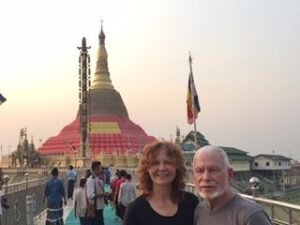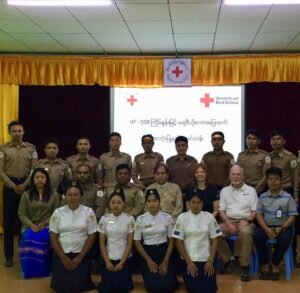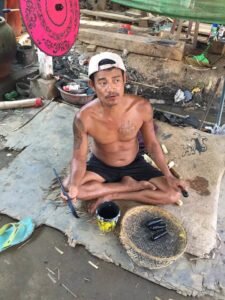White Elephants in Myanmar
Both Curse and Blessing
Asia is a place that for me, can never be “done”. No matter how many places I’ve been, there’s always something new, something exciting, something I haven’t experienced, food I haven’t tried, and cultural rites I haven’t witnessed. Especially in lesser known places, like Myanmar.
Mainstream destinations are popular for good reason, but there’s something to be said for waking up in Myanmar knowing that the day will hold surprises, often hiding in plain sight. These dispatches were written during a month while Glen and I were in Myanmar volunteering for the American Red Cross, testing and training a disaster emergency communications network. Driving through the countryside, working with different ethnic groups… it was the real Myanmar. I hope you find it as fascinating as we did.
Lucky White Elephants
I slid my shoes and socks under a bench among dozens of others at the Pagoda in Nya Pyi Taw, then saw a sign that long skirts were required for women. My long black pants were modest, but still pants. When I reached for my shoes to leave, a Myanmar woman motioned me into a small room, tied a long skirt around my waist and ushered me back to where Glen waited.
Unaccustomed to walking barefoot, my tender feet felt every pebble of gravel until Glen and I reached the cool marble steps of the pagoda terrace, overlooking, well … everything. Uppatasanti Pagoda towered above the sprawling hotels, abandoned construction sites and wide empty boulevards of Nay Pyi Taw, the military-built city that replaced Yangon (formerly Rangoon) as Myanmar’s capital in 2005. Taking in sweeping views, Glen pointed in the distance toward our own sparsely occupied hotel, then noticed an enclosure just below where we stood.
Pampered white elephants
“Are those elephants under that pavilion?” Guarded by a high steel fence and an assault rifle-wielding police officer, four perfectly pink elephants with white hairs and pale eyes munched on bamboo.
Foreigners are magnets for people wanting to practice English and pagodas are no exception. A young Buddhist monk noted our surprise at the elephants. “Buddha appeared as a white elephant. Very sacred. Very lucky.”
Up close they look pink
The reverence toward what, in Asia, are called white elephants (they look pink) made me wonder. I thought back to a Christmas party with a White Elephant theme where everyone gift wrapped an unwanted possession to be redistributed with friends’ unwanted items. How could a White Elephant be sacred in Asia and mean something without value in the West?
Unlucky Owners
Back at our hotel, I turned to the Google Meister for answers: Siamese (Thailand) kings were in the habit of bestowing lesser white elephants—mottled or deformed—to anyone who plotted against the king at court. As holy animals, white elephants could not be put to work to offset the enormous cost of being fed. Unable to get rid of such a royal gift, the plotters would inevitably go bankrupt from the cost of upkeep. Aside from honoring Buddha, the term White Elephant was applied to a possession which had value but cost more to maintain than the value it gave.I hope Glen and I give good value here in Myanmar training large numbers of Red Cross volunteer trainers and operators!!
Sweeping away bad deeds-I’ll try that!
Uppatasanti Pagoda
“It looks like those people are baptizing baby Buddha,” I told Glen. I don’t know a lot about Buddhism but was pretty sure that baptism wasn’t part of the religion. I pulled out my map of the grounds of Shwedagon Pagoda, adorned with 27 metric tons of gold leaf, thousands of gems, a 74-carat diamond and somewhere in the maze of brilliance, strands of Buddha's hair. The map informed that we were standing in front of something called a “Planetary Post”, which did nothing to explain why some worshippers were pouring cups of water over the head of a miniaturized Buddha and others knelt on the ground, bowed in prayer. The map showed eight planetary posts around the pagoda base and ever curious, Glen and I walked from one to the next trying to puzzle it out.Armed with a Myanmar telephone simcard, I stood and conferred with the Google Meister for the surprising answer; Myanmar Buddhists are strong believers of the influence of astrology, especially a person’s birth day, as in Monday, Tuesday… Each day is represented by an animal that possesses qualities passed to people born on their day. I was born on a Tuesday … do you know what day you were born?Monday people are TigersTuesday, Lions (Go Lions!!!)Wednesdays are tricky. If you were born in the morning you are an Elephant with a tusk, in the afternoon you are an elephant without a tusk. (Glen is a Wednesday morning elephant!)Thursday is Rat (my Thursday friends may want to double check their day of the week)Friday is a Guinea Pig (they are adorable)Saturday is a dragon (Game of Thrones fans will like that)Sunday is a stunning, mythical bird called a GarudaCrowded with worshippers, planetary posts are more than a parlor game to Myanmar Buddhists. Myanmar people try to do important things on their day; names are given according to their day, the name of their business is chosen according to their day, and they get married to a person whose day is friendly to their day. So, when someone goes to a pagoda to pay homage to Buddha, they also keep on friendly terms with their day by offering water, flower, incense and candle light at their planetary post.I hope my Myanmar Lion does not hurt my Chinese Zodiac Rooster!!
Toughen Your Feet for This One!
No nets, no opposing team, no score keeping… cane ball probably won’t catch on in the west. If it is possible to have a noncompetitivesport, that sport would be cane ball. In Myanmar it is called chinlone, and a Red Cross colleague in Yangon calls it Ninja Volleyball.The game consists of one team of six players who pass a woven rattan ball around in a circle using their heads, knees and feet. One player stands in the middle of the circle to perform solo, supported by those in the outer circle. Play stops once the ball has touched the ground before starting again as a new round.I’ve only seen it played barefoot in hard dirt and a colleague explained that the players use six main points of contact with the ball: the top of the toes; the sole of the foot; the instep and outstep of the foot; the heel; and the knee. There are also rules about how the nonplaying body parts must be positioned, but it sounded complicated.I picked up a cane ball at a market to get the heft, and it is so hard that players’ feet must be very tough. The players were intensely focused—no multitasking or texting possible. It is gripping to watch because any moment you expect someone will drop the ball. Cane ball. You heard it here first!
I Miss It — Don’t Miss It
I wanted to grab Glen’s hand to cross the street, thinking a driver might hesitate to take out two pedestrians at one time. But I pulled back my hand not wanting to offend—our Red Cross security handbook stressed, “No public displays of affection.”“Keep a steady pace with me,” Glen said, “and give the driver time to avoid hitting you, like with the cyclo drivers in Vietnam and Thailand.” That’s when I realized we had not seen even one motorcycle in Yangon. The ban on private car ownership was lifted in 2011 and used cars from Japan with right hand steering wheels clogged the right-hand drive — like in America— streets. It was the endless stream of cars we had been dodging. Suddenly it felt strange to be in a large Asian city and not terrorized by motorcycles.Our colleagues at the Red Cross delegation could not tell us why, just that motorcycles had been banned from Yangon. Perhaps a college age Myanmar woman I met at a restaurant might be willing to take a guess, but she shrugged, “My sister told me the ruling general’s daughter died in a motorcycle accident.” Her boyfriend said, “No, that was just a rumor. I think it is because before the military rule ended in 2015, a biker threatened a general with a finger-gun and escaped too easy on his motorcycle.”In other words, the people who really know why aren’t saying! Not that I want to negotiate more traffic on these streets, but it is curious.
Almsround
Everything a Buddhist monk owns or consumes is supposed to be donated, and every morning monks leave the monastery on an “alms round” to collect their meal of the day. They carry a big bowl and collect alms - mostly cooked food - from people in their community. Monks are not supposed to eat any food after 12:00, so that is the only meal they will consume all day. However, the monks seem to have plenty of food in their bowls, as donors receive "merit" that eventually helps him or her achieve release from the cycle of rebirth. A state that some call Nirvana.Glen and I have seen small numbers (1-12) monks walking in line collecting alms in the morning but returning from our training work today in late afternoon, close to 1,000 monks passed in line receiving food and small monetary donations from people along the road. It was a special parade sponsored by the government which happens only once a month. Lucky timing!





















